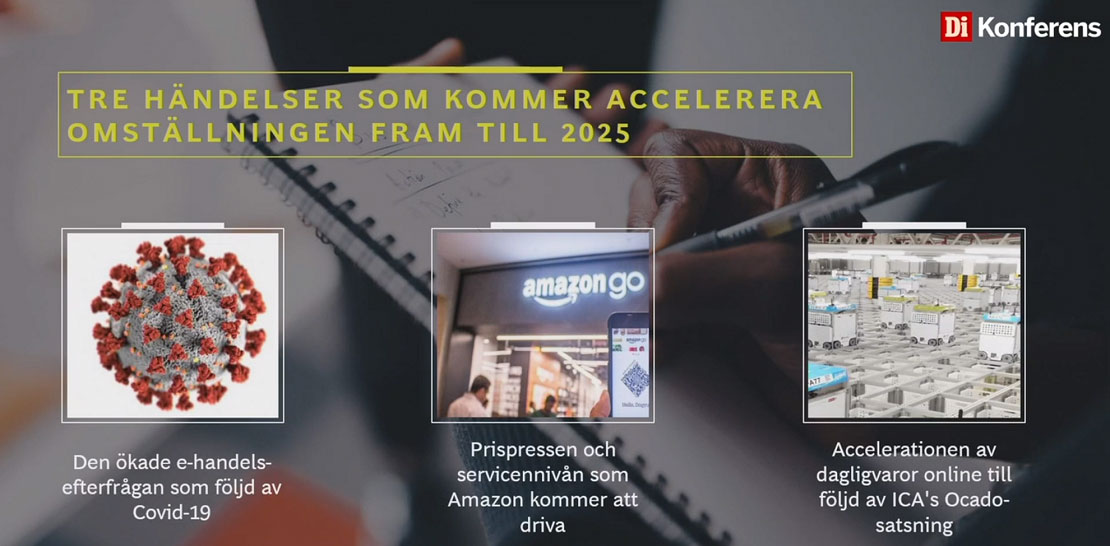Three years of development in three weeks - what happens when Sweden's largest e-retailer fast forward the strategy?
First out in an interview was Thomas Ekman, CEO of Dustin, who mainly sells to other companies. As early as January, they began to notice disruptions in deliveries from China. They then started buying up stocks to be able to meet demand. In March, home office products got a big boost when many started working from home and needed products there as well. Dustin also quickly began working on developing digital services. When customer behavior changes so quickly, it provides an opportunity to drive strategy and development. What was nevertheless included in a long-term plan to be implemented, now had to be implemented quickly.
Thomas believes that this mix of how we work at home and in the office will continue for a long time and that we will find a new way of working where possible. Having a good home office is increasingly important for those customers. Being forced to start using digital services makes it possible to discover the benefits that one might otherwise have missed. Just having to do something is a driving force.
About 2.5 years ago, Dustin started selling their own brands. They started in segments where customers may not care so much about brands and where it is possible to have good margins such as cables and accessories. Depending on customer behavior and pricing, 50% of Dustin's purchases are made by a robot. Thousands of prices change every day automatically. The employees who previously did these tasks can now instead work more creatively.
The impact of the Corona crisis on the digital transformation of trade
Karin Johansson, CEO of Svensk Handel, shared figures from the trade during the past 7 months. The wholesale trade has taken a lot of beatings and the grocery trade has increased like never before. Gardening and products for our home have also increased, as well as products for the home office. We have not been in the cities in the same way as before, which has affected trade in the city centers, while the vacations near the home meant that more people chose to holiday at home in Sweden and put their holiday money there instead of abroad.
E-commerce growth is historically high, even the 70-plus found e-commerce during the pandemic to a greater extent. During Q2, e-commerce in Sweden grew by 45%, historically high figures. The grocery trade, which has a small share that takes place online, has in many cases doubled online.

A clear trend is value-driven trading. Sustainability is in focus. Companies are expected to help make the world a better place. Customers vote with their feet, they go if the company's attitude and values do not appeal to them.
When we now have to navigate without a map, we see an increased pace of innovation in the crisis. We have had to find new delivery methods, stores have become warehouses with direct deliveries to customers, collaborations between retailers have popped up and the digital meeting has sharpened.
The future of e-commerce - with a focus on new trading structures after Covid-19
Thomas Jensen, Sweden manager at Boston Consulting Group,
talked about how the Swedish trade map will be redrawn. Covid-19 is not the beginning or the end, but a catalyst. Thomas mentioned three events that he believes will accelerate the transition until 2025.
- The increased e-commerce demand as a result of Covid-19.
New target groups have started shopping more online. Capacity and services have increased and prices for distribution have been reduced.
- The price pressure and the level of service that Amazon will drive.
Amazon is not the cheapest at all, but they are cheap where they knows it matters to customers such as bestsellers.
- The acceleration of groceries online as a result of ICA's Ocado investment.
When ICA buys a sophisticated grocery trading system such as Ocado, this drives development forward for anyone who wants to sell food online. It will change Swedes' expectations of e-commerce.
Thomas concludes by giving some tips on what it takes to succeed as customer-centric delivery solutions, strong range of own / unique goods, competitive prices, data analysis integrated in everything and to build and reward loyalty. Using the physical stores to their advantage in an omnichannel solution will be a success factor for those who meet customers both digitally and offline.

From a CD store to the Nordic region's largest marketplace
has been on a long journey of change. Today, CDON.com has 8 million products in its marketplace, but 21 years ago they were pioneers in the sale of CDs.
Kristoffer Väliharju, CEO of CDON, talks about the importance of relating to Amazon as a driving force and not just complaining that they are on their way into Sweden. They have seen an increase in retailers wanting to join after the launch of Amazon was completed this year. CDON only runs music, games and films on their own nowadays, all other areas where they have been involved before they have left such as beauty, garden and home decor to make room for traders in the marketplace.
Kristoffer emphasizes the importance of personalization when you have so many products in one marketplace. If there are product categories that are not relevant to me as a customer, there is no point in showing them on the start page or in newsletters. To offer the variety, but to package it into a relevant customer offer. Being responsive to customers is something they spend a lot of time on, if customers want live video shopping, they should be able to offer it. If customers prefer to pay by card, then that option must be available.
How to build a strong global brand together with the customer - the digital native way
|
Pernilla Nyrensten is the CEO and co-founder of Revolutionrace, who offers casual wear. They managed to find the gap that many are looking for where they found new target groups such as the urban customer who moves between city and outdoor life. She says that Facebook usually says that they are an outdoor company built via their platform. Pernilla says that right from the start, they built a community to also give customers influence in product selection and function. In many cases, it is their customers who are in their marketing videos. It has always been important to be informative because there are so many features that need to be described for the garments. Before Corona, there were plans to invest physically, but now e-commerce has grown and they feel that they are properly positioned at the moment. The plan was to continue to own the entire chain without resellers in order to continue to have close customer contact even if they were to start selling in a physical channel. Transparent marketing dialogue and giving customers more than they expect have been success factors for Revolutionrace, which is investing in continued growth in Europe. The planned expansion to the United States will have to wait another year. |
@scassa24 |
Towards new heights for Europe's largest e-commerce group for the home
BHG Group mainly sells home furnishings, building materials and garden products. They have made more than 30 acquisitions since 2012, one of the reasons why they have been able to grow strongly with their own brands. In the Nordic region, they are dominant online and rapidly growing within the EU in their market.
Adam Schatz, CEO of BHG Group, indicates dynamic pricing as an important part of the core strategy. With a network of 80 showrooms, they see that they have a good position versus competitors who only invest online. In their show rooms they can have some outdoor furniture for those customers who want to squeeze and feel before a purchase.
Additional services are used to simplify for customers. Not only to sell a kitchen faucet to a customer, but also to be able to offer to install it. They collaborate with a network of partners that is nationwide. They have developed a platform to connect the entire chain and be able to measure customer satisfaction on installations and improve the process.
In the next part, we continue to share trends from the conference Di e-commerce where the grocery trade's enormous growth, change journeys and more sustainable e-commerce are in focus.

